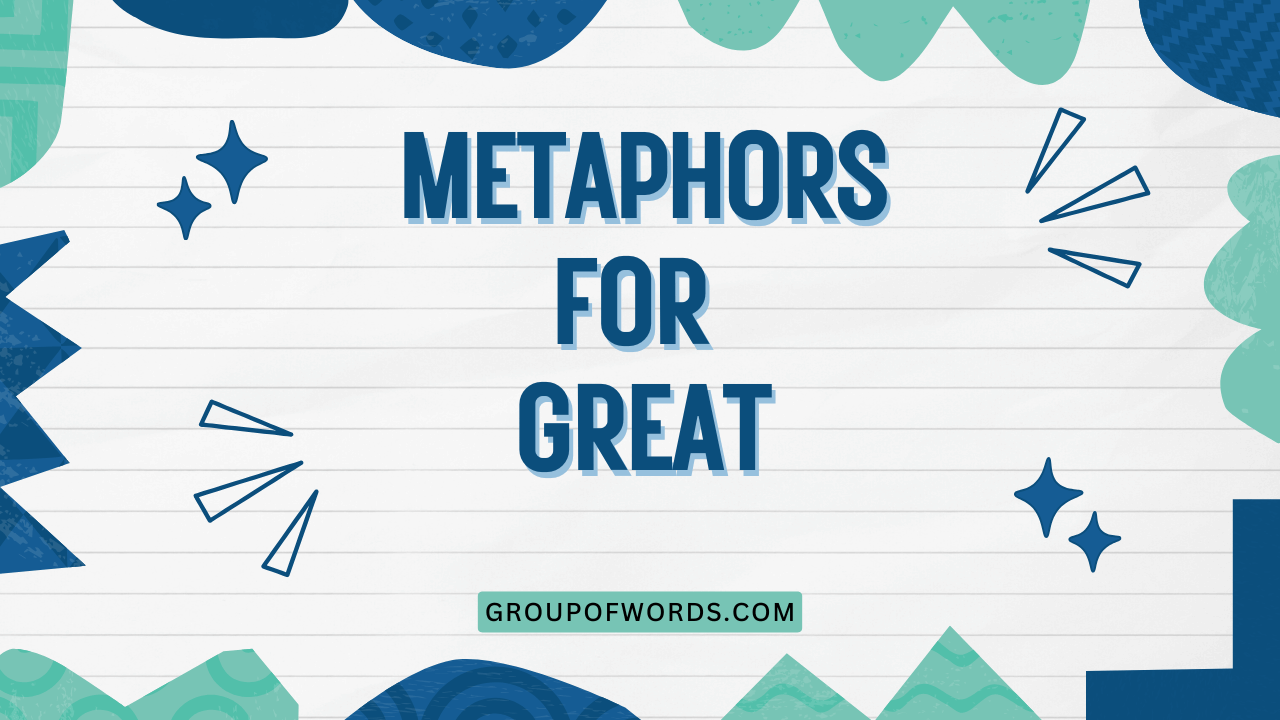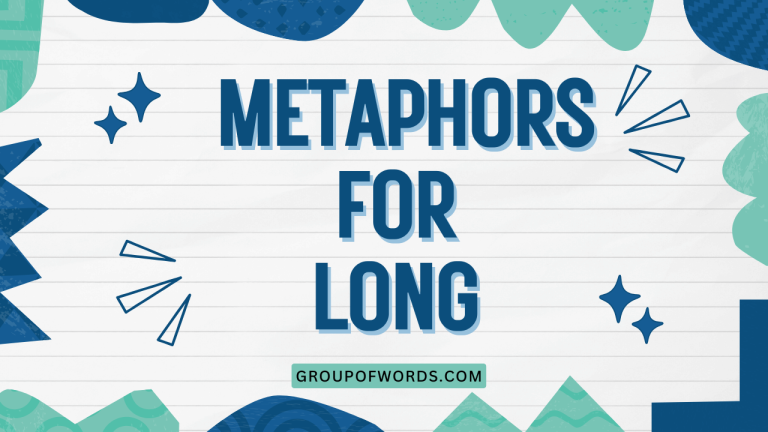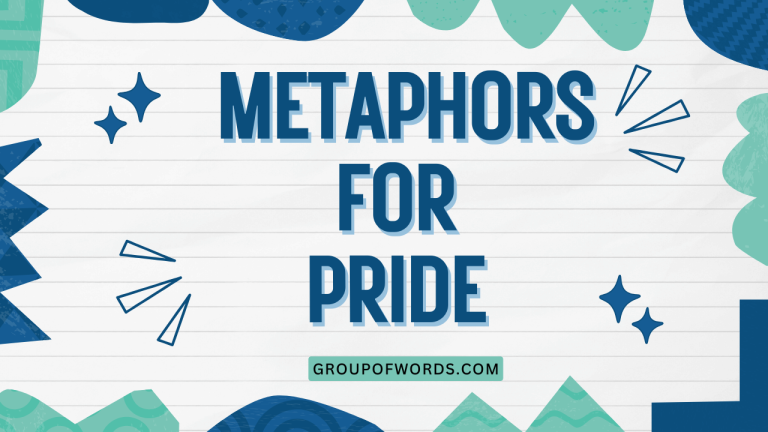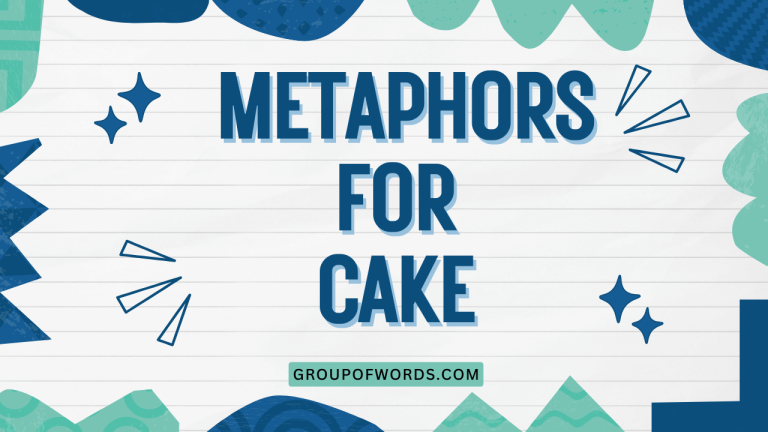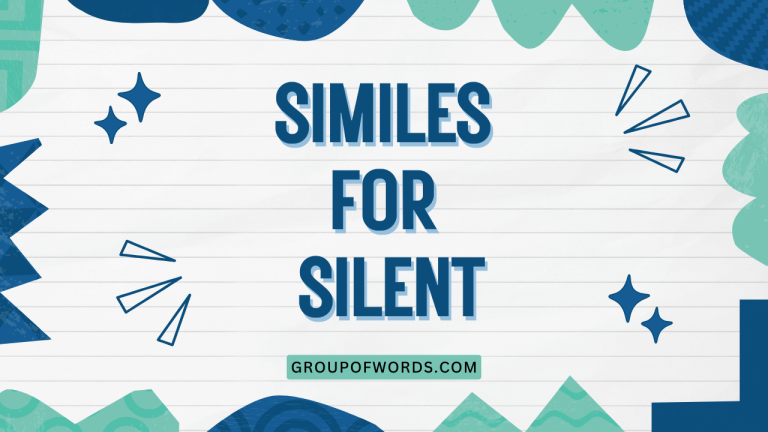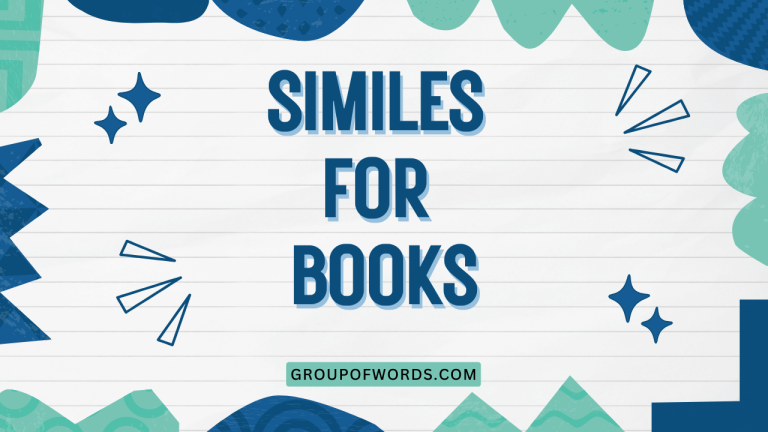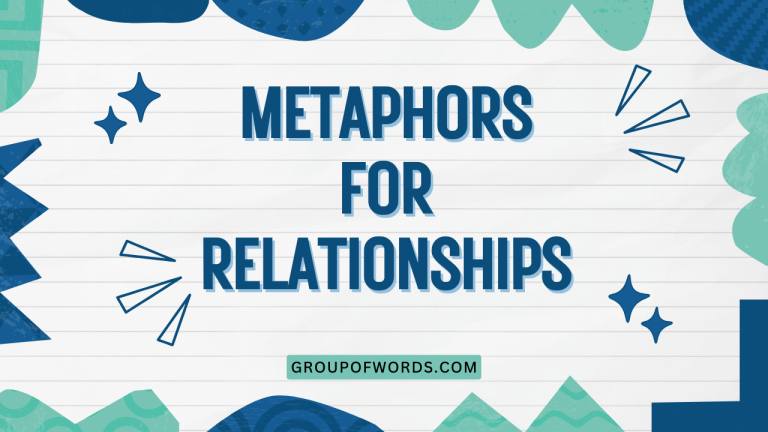Magnificent Metaphors: Expressing “Great” in English
Metaphors are powerful tools in the English language, allowing us to convey concepts in vivid and imaginative ways. When it comes to expressing the idea of “greatness,” metaphors can add layers of meaning and emotional impact that simple adjectives like “good” or “big” often lack.
Understanding these metaphors not only enriches your vocabulary but also enhances your ability to appreciate and create expressive language. This article will explore a wide range of metaphors for “great,” providing definitions, examples, usage rules, and practice exercises to help you master this aspect of English grammar.
This guide is suitable for English language learners of all levels, from intermediate to advanced, as well as native speakers looking to refine their understanding of figurative language.
Table of Contents
- Introduction
- Definition of Metaphor for “Great”
- Structural Breakdown
- Types and Categories of Metaphors for “Great”
- Examples of Metaphors for “Great”
- Usage Rules for Metaphors
- Common Mistakes
- Practice Exercises
- Advanced Topics
- FAQ
- Conclusion
Definition of Metaphor for “Great”
A metaphor is a figure of speech that directly compares two unrelated things, suggesting a similarity or shared characteristic between them. When used to describe something as “great,” a metaphor goes beyond literal description and evokes a sense of exceptional quality, size, power, or impact.
This indirect comparison allows for a more vivid and nuanced understanding of the subject’s greatness, making it more memorable and emotionally resonant.
In essence, metaphors for “great” function as descriptive adjectives that replace or enhance literal terms like “good,” “large,” or “important.” They add depth and color to our language, turning simple statements into evocative imagery. The effectiveness of a metaphor depends on the audience’s ability to recognize the underlying similarity being drawn between the two seemingly different concepts.
For instance, saying “He is a giant in the field of medicine” doesn’t literally mean the person is physically large. Instead, it metaphorically suggests they are exceptionally accomplished, influential, and respected within their profession, drawing a parallel between their stature and the immense size and strength associated with a giant.
Structural Breakdown
The basic structure of a metaphor involves two key elements: the tenor (the subject being described) and the vehicle (the object or concept used to represent the subject). The connection between the tenor and vehicle is the ground, which is the shared characteristic or similarity that makes the metaphor work. To illustrate:
- Tenor: The achievement
- Vehicle: A mountain
- Metaphor: The achievement was a mountain to climb.
- Ground: Difficulty, challenge, and imposing scale.
In this example, the achievement (tenor) is being compared to a mountain (vehicle). The ground, or the shared characteristic, is the difficulty and imposing nature of both.
The metaphor suggests that the achievement was challenging and required significant effort to overcome.
Metaphors for “great” often follow this structure, using vehicles that represent qualities associated with greatness, such as immense size, overwhelming power, exceptional quality, or lasting impact. Understanding this structural breakdown can help in both interpreting and creating effective metaphors.
Furthermore, the effectiveness of a metaphor relies on the audience’s understanding of the vehicle. If the audience is unfamiliar with the qualities associated with the vehicle (e.g., if they don’t know that mountains are often difficult to climb), the metaphor will fail to convey its intended meaning.
Types and Categories of Metaphors for “Great”
Metaphors for “great” can be categorized based on the specific aspect of greatness they emphasize. Here are some common categories:
Metaphors of Size and Scale
These metaphors use concepts of immense size or scale to convey the magnitude of something. They often involve comparisons to natural phenomena or large objects.
Metaphors of Power and Influence
These metaphors emphasize the strength, authority, or impact of something. They may involve comparisons to powerful forces, leaders, or institutions.
Metaphors of Quality and Excellence
These metaphors highlight the superior nature, skill, or artistry of something. They often involve comparisons to precious materials, masterpieces, or exceptional individuals.
Metaphors of Impact and Effect
These metaphors focus on the significant consequences or influence of something. They may involve comparisons to events that cause widespread change or lasting impressions.
Metaphors of Value and Worth
These metaphors underscore the importance, significance, or desirability of something. They often involve comparisons to precious commodities, treasures, or essential resources.
Metaphors of Rarity and Uniqueness
These metaphors emphasize the exceptional or unparalleled nature of something. They may involve comparisons to rare artifacts, one-of-a-kind creations, or singular events.
Examples of Metaphors for “Great”
Here are some examples of metaphors for “great,” organized by category:
Size and Scale Examples
The following table provides examples of metaphors that use size and scale to convey “greatness,” often relating to magnitude or scope.
| Metaphor | Meaning | Example Sentence |
|---|---|---|
| A towering figure | An extremely influential or respected person. | In the world of science, Marie Curie remains a towering figure. |
| A giant in the industry | A very large and successful company or person. | Amazon is a giant in the industry of online retail. |
| A colossus | Something of immense size and power. | The Roman Empire was once a colossus that dominated the Mediterranean. |
| An ocean of knowledge | A vast amount of knowledge. | The library contained an ocean of knowledge waiting to be explored. |
| A mountain of work | A large and overwhelming amount of work. | I have a mountain of work to complete before the deadline. |
| A universe of possibilities | An infinite number of possibilities. | With this new technology, there’s a universe of possibilities for innovation. |
| A world of difference | A very significant difference. | There’s a world of difference between their approaches to management. |
| An empire | A vast and powerful organization or entity. | His business had become an empire spanning multiple continents. |
| A leviathan | Something very large and powerful. | The corporation was a financial leviathan, capable of influencing global markets. |
| A vast expanse | A large and open area. | The internet offers a vast expanse of information. |
| A kingdom | A realm or area of expertise. | She rules her kitchen like it’s her own kingdom. |
| A sea of faces | A large crowd of people. | The speaker looked out at a sea of faces in the audience. |
| A chasm | A significant divide or difference. | There’s a chasm between their beliefs and mine. |
| A gulf | A wide gap or separation. | A gulf of misunderstanding separated the two parties. |
| A canyon | A deep divide or difference. | The debate revealed a deep canyon between their political ideologies. |
| A horizon | A broad range of possibilities. | Studying abroad expanded her horizon. |
| A continent | A large and significant area. | The book covers a continent of information. |
| A galaxy | A vast collection. | The museum holds a galaxy of artifacts. |
| A cosmos | An ordered system. | He tried to bring a cosmos of order to the chaotic office. |
| A grand scale | An extensive level. | The project was completed on a grand scale. |
| An enormous undertaking | A huge task. | Building the bridge was an enormous undertaking. |
| A monumental achievement | A great success. | Winning the gold medal was a monumental achievement. |
| A Herculean effort | A great effort. | It took a Herculean effort to finish the project on time. |
Power and Influence Examples
The following table presents metaphors that use power and influence to express the “greatness” of something, highlighting its impact and authority.
| Metaphor | Meaning | Example Sentence |
|---|---|---|
| A force to be reckoned with | Someone or something that cannot be ignored. | The new company is a force to be reckoned with in the tech industry. |
| A driving force | A major influence or cause. | Innovation is the driving force behind their success. |
| A powerhouse | A source of great strength or energy. | The university is a powerhouse of research and development. |
| A titan | Someone very powerful and influential. | He was a titan of industry, shaping the landscape of modern business. |
| A juggernaut | An unstoppable force. | The marketing campaign was a juggernaut, sweeping across social media. |
| A magnetic personality | Someone who attracts people with their charm and influence. | The leader had a magnetic personality that inspired loyalty. |
| A commanding presence | Someone who exudes authority and respect. | The CEO had a commanding presence that filled the room. |
| A dominant player | Someone who has a major influence or control. | They are a dominant player in the global market. |
| A major league | The highest level of competition or achievement. | He’s playing in the major league now. |
| An iron fist | A firm and authoritarian control. | The dictator ruled with an iron fist. |
| A strong hand | Firm and decisive leadership. | The company needed a strong hand to guide it through the crisis. |
| A guiding light | Someone who provides direction and inspiration. | Her mentor was a guiding light throughout her career. |
| A pillar of strength | Someone who provides support and stability. | He was a pillar of strength for his family during difficult times. |
| A force field | A protective barrier or influence. | His reputation created a force field around him, protecting him from criticism. |
| A vortex | A situation or activity that absorbs everything around it. | The scandal became a vortex, pulling everyone involved into its center. |
| A catalyst | Something that causes a change or action. | The new policy acted as a catalyst for innovation. |
| A game changer | Something that fundamentally alters the course of events. | The new technology was a game changer in the industry. |
| A watershed moment | A turning point in history or a situation. | The election was a watershed moment for the country. |
| A seismic shift | A significant and widespread change. | The internet caused a seismic shift in the way we communicate. |
| A tidal wave | An overwhelming force or influence. | The support for the cause was like a tidal wave. |
| A reign | A period of dominance. | Her reign as champion lasted for five years. |
| A vanguard | A leading position. | They were at the vanguard of technological innovation. |
| A lodestar | Something that serves as a guide. | His principles served as a lodestar for his actions. |
Quality and Excellence Examples
The following table showcases metaphors that use quality and excellence to express “greatness,” often emphasizing superior attributes and achievements.
| Metaphor | Meaning | Example Sentence |
|---|---|---|
| A diamond in the rough | Someone with great potential but lacking refinement. | She was a diamond in the rough, waiting to be discovered. |
| A shining star | Someone who is exceptionally talented or successful. | He is a shining star in the world of classical music. |
| The gold standard | The highest level of quality or excellence. | Their customer service is the gold standard in the industry. |
| A masterpiece | An outstanding work of art or craftsmanship. | The painting is considered a masterpiece of the Renaissance. |
| A work of art | Something created with exceptional skill and beauty. | The architecture of the building is a true work of art. |
| A virtuoso | Someone with exceptional technical skill in a particular art. | He is a virtuoso on the violin. |
| A prodigy | Someone with exceptional talent at a young age. | She was a child prodigy on the piano. |
| A legend | Someone who is famous and admired for their achievements. | He is a legend in the world of sports. |
| An icon | Someone who is widely recognized and admired as a symbol of something. | She became an icon of the feminist movement. |
| The cream of the crop | The best of a group or category. | Only the cream of the crop are selected for the team. |
| A cut above | Significantly better than the rest. | Their service is a cut above the competition. |
| A paragon | A model of excellence or perfection. | He is a paragon of virtue. |
| A benchmark | A standard against which others are measured. | Their success became the benchmark for other companies. |
| A standard-bearer | A leader in a particular field. | She is a standard-bearer for ethical journalism. |
| A gem | Something of great value and beauty. | The old theater was a gem, hidden in the heart of the city. |
| A treasure | Something highly valued and cherished. | Her friendship is a treasure I will always cherish. |
| A crown jewel | The most valuable or prized possession. | The museum’s collection is its crown jewel. |
| A pearl | Something rare and beautiful. | Her insights were like pearls of wisdom. |
| A work of genius | An exceptionally intelligent creation. | Einstein’s theory of relativity was a work of genius. |
| A stroke of brilliance | A sudden and remarkable idea or achievement. | His solution to the problem was a stroke of brilliance. |
| A class act | Someone who exhibits elegance and grace. | She handled the situation like a true class act. |
| A refined taste | An appreciation for high-quality things. | He had a refined taste for art and music. |
| A touch of magic | A special ability or quality. | The chef added a touch of magic to the dish. |
Impact and Effect Examples
This table provides metaphors using impact and effect to describe “greatness,” highlighting significant consequences and lasting impressions.
| Metaphor | Meaning | Example Sentence |
|---|---|---|
| A ripple effect | A spreading series of consequences caused by a single action. | The company’s decision had a ripple effect throughout the industry. |
| A domino effect | A chain reaction of events. | One mistake led to a domino effect of failures. |
| A tidal wave of change | An overwhelming and transformative change. | The new law brought a tidal wave of change to the country. |
| A sea change | A significant and profound transformation. | The internet brought about a sea change in communication. |
| A game-changer | Something that fundamentally alters the course of events. | The invention of the smartphone was a game-changer. |
| A turning point | A moment when a significant change occurs. | The discovery marked a turning point in the history of medicine. |
| A landmark decision | A decision that sets a precedent and has lasting impact. | The Supreme Court’s ruling was a landmark decision. |
| A milestone | A significant achievement or event. | Reaching one million customers was a major milestone for the company. |
| A beacon of hope | Something that provides guidance and inspiration. | The organization became a beacon of hope for refugees. |
| A pillar of society | Someone or something that provides essential support. | Education is a pillar of society. |
| A cornerstone | An essential foundation or basis. | Trust is the cornerstone of any successful relationship. |
| A seed of change | The initial spark for a significant transformation. | His ideas planted the seed of change in the community. |
| A catalyst for change | Something that initiates or accelerates change. | The protest served as a catalyst for change. |
| A breath of fresh air | Something new and refreshing. | Her innovative ideas were a breath of fresh air. |
| A shot in the arm | Something that provides a boost or stimulus. | The new investment was a shot in the arm for the local economy. |
| A force multiplier | Something that amplifies the effectiveness of an action. | Technology is a force multiplier in modern warfare. |
| A game plan | A strategy or approach. | They developed a game plan for achieving their goals. |
| A recipe for success | A set of ingredients or actions that lead to success. | Hard work and dedication are a recipe for success. |
| A blueprint | A detailed plan or design. | They created a blueprint for the new city. |
| A chain reaction | A sequence of events where each event triggers the next. | The accident caused a chain reaction of delays. |
| A domino effect | A situation in which one event causes a series of similar events to happen one after another. | The closure of the factory had a domino effect on local businesses. |
| A snowball effect | A situation in which something increases rapidly in size or importance. | The scandal began with a small lie, but it quickly had a snowball effect. |
Value and Worth Examples
The following table provides examples of metaphors that use value and worth to convey “greatness,” emphasizing importance and significance.
| Metaphor | Meaning | Example Sentence |
|---|---|---|
| A priceless asset | Something extremely valuable and irreplaceable. | Her experience is a priceless asset to the company. |
| A golden opportunity | A very favorable chance or opportunity. | This is a golden opportunity to invest in the company. |
| A treasure trove | A collection of valuable or delightful things. | The museum is a treasure trove of historical artifacts. |
| A wealth of knowledge | A large amount of knowledge. | He has a wealth of knowledge on the subject. |
| A gold mine | A valuable source of something. | The research data is a gold mine of information. |
| A diamond in the crown | The most valuable or cherished item. | The company’s new product is the diamond in the crown. |
| A rare find | Something that is difficult to find and highly valued. | The antique book was a rare find. |
| A hidden gem | Something valuable or delightful that is not widely known. | The small restaurant is a hidden gem. |
| A pearl of wisdom | A valuable piece of advice or insight. | His words were pearls of wisdom. |
| A pot of gold | A great reward or opportunity. | At the end of the rainbow, there is a pot of gold. |
| A lifeline | Something that provides essential support or assistance. | The loan was a lifeline for the struggling business. |
| The key to success | The essential element for achieving success. | Hard work is the key to success. |
| The heart of the matter | The most important or essential aspect. | The heart of the matter is that we need more funding. |
| A bridge | Something that connects or facilitates communication. | Education is a bridge to a better future. |
| A cornerstone | The most important part of something. | Honesty is the cornerstone of any good relationship. |
| A foundation | The basis or groundwork for something. | Education provides a foundation for success. |
| An anchor | Something that provides stability and support. | His family was his anchor during difficult times. |
| A buffer | Something that protects or reduces the impact of something. | Savings can be a buffer against unexpected expenses. |
| A shield | Something that protects from harm or danger. | Her reputation was a shield against criticism. |
| A safety net | A safeguard against failure or hardship. | Unemployment benefits provide a safety net for workers. |
Usage Rules for Metaphors
Using metaphors effectively requires careful consideration of context, audience, and intended meaning. Here are some key rules to follow:
- Clarity: Ensure the metaphor is understandable and relevant to your audience. Avoid obscure or overly complex comparisons.
- Relevance: The connection between the tenor and vehicle should be logical and meaningful. The shared characteristic (ground) should be apparent.
- Consistency: Avoid mixing metaphors within the same sentence or paragraph, as this can create confusion and weaken the impact.
- Originality: While common metaphors can be effective, strive to create fresh and original comparisons to capture your audience’s attention and add novelty to your writing.
- Appropriateness: Consider the tone and style of your writing. Metaphors should be appropriate for the context and avoid being overly dramatic or sentimental.
- Avoid Clichés: Try to avoid overused metaphors (clichés) as they can sound unoriginal and lack impact. Find fresh ways to express your ideas.
Common Mistakes
Here are some common mistakes to avoid when using metaphors:
- Mixed Metaphors: Combining two or more inconsistent metaphors.
- Incorrect: “We must nip it in the bud before it snowballs into a raging inferno.” (Mixing “nip in the bud” and “snowballs into a raging inferno”)
- Correct: “We must nip it in the bud before it becomes a problem.”
- Correct: “We must act quickly before the situation snowballs into a crisis.”
- Overused Clichés: Using metaphors that have become stale and unoriginal.
- Cliché: “He was as brave as a lion.”
- Better: “He faced the challenge with unwavering courage.”
- Inappropriate Tone: Using metaphors that are inconsistent with the overall tone of your writing.
- Inappropriate: “The surgery was a walk in the park.” (In a serious medical report)
- Better: “The surgery proceeded without complications.”
- Lack of Clarity: Using metaphors that are confusing or difficult to understand.
- Unclear: “His mind was a labyrinth of thoughts.”
- Clearer: “His mind was filled with complex and conflicting thoughts.”
Practice Exercises
Test your understanding of metaphors for “great” with these exercises:
Exercise 1: Identify the Metaphor
Identify the metaphor in each sentence and explain its meaning.
| Question | Answer |
|---|---|
| 1. She is a shining star in the company. | Metaphor: Shining star. Meaning: She is exceptionally talented and successful. |
| 2. His speech was a tidal wave of emotions. | Metaphor: Tidal wave. Meaning: His speech was filled with an overwhelming amount of emotion. |
| 3. The new technology is a game-changer for the industry. | Metaphor: Game-changer. Meaning: The technology will fundamentally alter the industry. |
| 4. The project was a mountain to climb. | Metaphor: Mountain. Meaning: The project was very difficult and challenging. |
| 5. He is a pillar of the community. | Metaphor: Pillar. Meaning: He provides essential support and strength to the community. |
| 6. Her knowledge is an ocean. | Metaphor: Ocean. Meaning: Her knowledge is vast and deep. |
| 7. The company is a powerhouse in the market. | Metaphor: Powerhouse. Meaning: The company is strong and influential. |
| 8. Their success is the gold standard. | Metaphor: Gold standard. Meaning: Their success represents the highest level of quality. |
| 9. He’s a titan of the industry. | Metaphor: Titan. Meaning: He’s a very powerful and influential person in the industry. |
| 10. The agreement was a cornerstone of the peace process. | Metaphor: Cornerstone. Meaning: The agreement was an essential foundation for the peace process. |
Exercise 2: Complete the Metaphor
Complete the following sentences with an appropriate metaphor for “great.”
| Question | Answer |
|---|---|
| 1. The discovery was a ________ for the field of medicine. | Answer: Breakthrough |
| 2. Her dedication to the cause made her a ________ of hope. | Answer: Beacon |
| 3. The new policy acted as a ________ for innovation. | Answer: Catalyst |
| 4. His leadership was the ________ of the company’s success. | Answer: Key |
| 5. The museum is a ________ of ancient artifacts. | Answer: Treasure Trove |
| 6. The team’s performance was a ________. | Answer: Masterpiece |
| 7. The internet has created a ________ of information. | Answer: Universe |
| 8. She is a ________ in the world of art. | Answer: Legend |
| 9. His work is a true ________. | Answer: Gem |
| 10. The invention was a ________ in the history of technology. | Answer: Milestone |
Exercise 3: Create Your Own Metaphor
Create your own metaphor for “great” to describe the following:
| Question | Answer |
|---|---|
| 1. A successful entrepreneur | Answer: A visionary architect, building an empire from the ground up. |
| 2. A talented musician | Answer: A symphony conductor, orchestrating emotions through sound. |
| 3. A dedicated teacher | Answer: A nurturing gardener, cultivating young minds with care and patience. |
| 4. An innovative scientist | Answer: An intrepid explorer, charting new territories of knowledge. |
| 5. A skilled athlete | Answer: A graceful dancer, moving with precision and artistry. |
Advanced Topics
For those seeking to deepen their understanding of metaphors, consider these advanced topics:
- Extended Metaphors: Explore how to sustain a metaphor throughout an entire piece of writing, creating a richer and more complex image.
- Subverted Metaphors: Learn how to intentionally twist or contradict a common metaphor to create a surprising or humorous effect.
- Conceptual Metaphors: Investigate the underlying cognitive structures that shape our understanding of abstract concepts and how metaphors reflect these structures.
- Cross-Cultural Metaphors: Examine how metaphors vary across different languages and cultures, and how these differences can impact communication.
FAQ
What is the difference between a metaphor and a simile?
Both metaphors and similes are figures of speech that compare two unlike things. However, a metaphor directly equates the two things, while a simile uses “like” or “as” to make the comparison.
For example, “He is a lion” (metaphor) vs. “He is as brave as a lion” (simile).
How can I avoid using clichés in my writing?
To avoid clichés, try to come up with original comparisons that are specific to your subject. Think about the unique qualities of the thing you are describing and find a fresh way to express those qualities.
Can a metaphor be too complex?
Yes, a metaphor can be too complex if it is difficult for your audience to understand. The best metaphors are those that are clear, relevant, and easy to grasp.
How do I know if a metaphor is appropriate for my audience?
Consider your audience’s background knowledge and cultural context. Choose metaphors that are likely to resonate with them and avoid comparisons that may be unfamiliar or offensive.
What is the role of metaphors in persuasive writing?
Metaphors can be powerful tools in persuasive writing because they can evoke emotions, create vivid images, and make abstract concepts more concrete and relatable. They can also help to frame an argument in a way that is more appealing to the audience.
Conclusion
Metaphors are essential tools for expressing the nuances of “greatness” in the English language. By understanding the structural breakdown of metaphors, exploring different categories, and following usage rules, you can effectively incorporate these figures of speech into your writing and speech.
Avoiding common mistakes and continuously practicing will refine your ability to create impactful and original metaphors. As you advance, exploring more complex aspects like extended and conceptual metaphors will further enhance your linguistic toolkit, allowing you to convey ideas with greater clarity, depth, and emotional resonance.
Whether you are an English language learner or a native speaker, mastering metaphors will undoubtedly enrich your communication skills and elevate your understanding of the English language.
